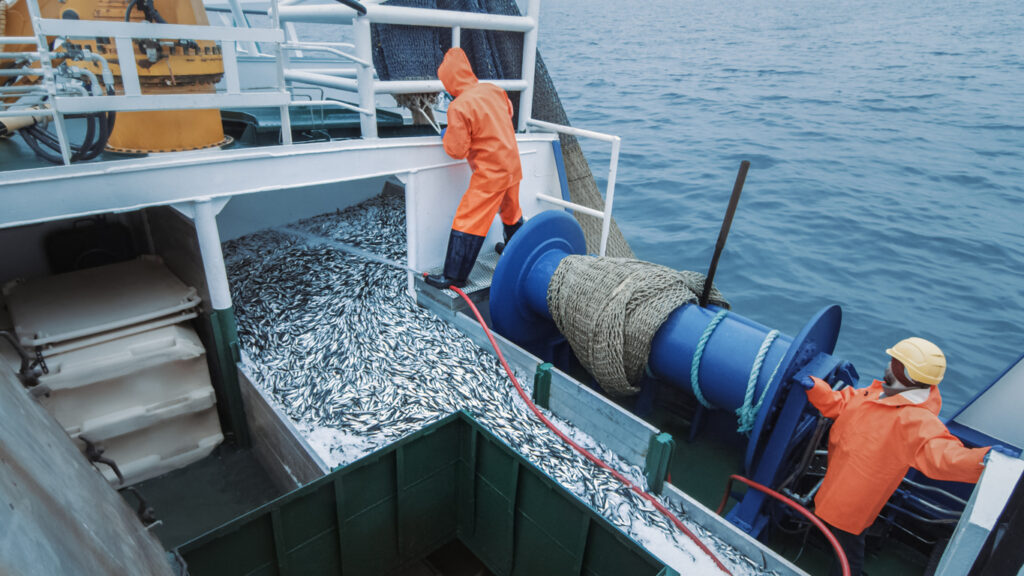A new study, led by Dr Angus Atkinson, the Plymouth Marine Laboratory, sheds light on a pressing concern: climate change is silently undermining the Ocean’s capacity to sustain fish populations. Co-authored by Mercator Ocean International’s oceanographer Maria Grigoratou and 9 authors from 6 different countries, the research uncovers a hidden amplification mechanism when changes in the population of one species cause even bigger changes in the populations of other species further up the food chain. The study showed that a relatively small reduction in phytoplankton populations can result in a major decline in fish stocks.
The research exposes a previously unknown domino effect within the marine food web: a slight fall in phytoplankton levels can trigger a substantial fall in fish populations
The study, published in Nature Communications, provides a fresh view onto the dynamics of phytoplankton, tiny plants that form the base of the marine food web, and fish populations. Drawing on global-scale data models and field observations over 41 different ecosystems, researchers reveal a worrying trend. When climate warming reduces phytoplankton levels by 16% – as projected by global models in regions like the North Atlantic – the carrying capacity for fish plummets by 38%.
Global models have long projected declines in phytoplankton levels, especially in regions like the North Atlantic where plankton abundance has already changed over the past five decades. However, how fish, particularly commercially exploited fish stocks, might be affected by changes in plankton, has remained uncertain. This study fills that gap by providing a perspective based on empirical data.
“Our study highlights the importance of using observations directly from the Ocean”, explains Dr Maria Grigoratou, oceanographer at Mercator Ocean. “To make the right decisions for our planet’s future and its sustainability, we need trustworthy, long-term data collected from the Ocean. This information helps us keep track of how the Ocean is changing and make better predictions about what might happen next.”
An approach breaking barriers and bringing the community together
Through the support of the international size spectrum reading group SPECTRE, the research team collaborated and adopted an innovative approach, analysing plankton size distribution to assess the efficiency of the food web.
“This research project began as a collaboration between scientists from the UK and Germany. The SPECTRE group, which helps researchers connect and work together, brought together experts from Australia, Canada, France, and Greece to contribute to the study. This international teamwork highlights the importance of global cooperation in advancing scientific knowledge”, confirms Maria Grigoratou, who has been organising the group since February 2021.
As they compiled a comprehensive global database on marine and freshwater plankton size distribution, they uncovered the factors dictating energy flow within the food web. Surprisingly, they found that temperature, often implicated in food web disruptions, played a secondary role. Instead, the primary driver was the overall abundance of phytoplankton, which governs the efficiency of energy transmission from small plankton to larger fish.
“Our study challenges our understanding of the relationship between temperature and marine food web efficiency and emphasizes the importance of phytoplankton in maintaining healthy oceans. High temperatures and reduced nutrients due to warming lead to smaller plankton, disrupting energy transfer and making it harder for fish to find food” says Dr Angus Atkinson, scientist at the Plymouth Marine Laboratory.
The study underscores the urgency of integrating climate change considerations into fisheries management strategies. The research advocates for a multi-faceted approach, combining data on plankton size structure with sophisticated computer models to develop resilient, climate-smart fisheries management plans.
Additional Resources
- G7 Future of the Seas and Ocean Initiative inter-sessional activities on a marine plankton observing network
- NECCTON, a system enabling the Copernicus Marine Service to deliver products that inform marine biodiversity conservation and food resources management, incl. a higher trophic level modelling capability
- BioEcoOcean, an EU project and innovative tool to increase the utility of Ocean observationshttps://www.uu.se/en/news/archive/2023-09-12-a-tool-to-increase-the-utility-of-ocean-observations

